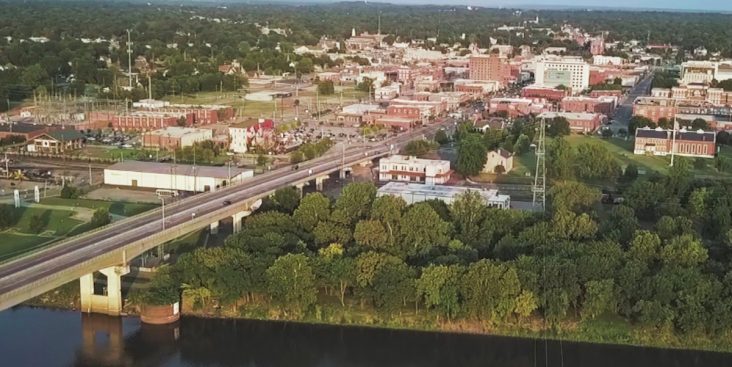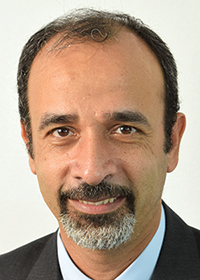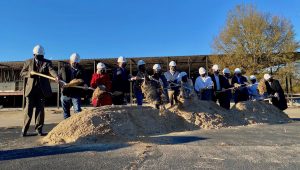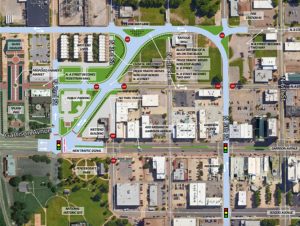Research facility, economic strength part of top 2020 Fort Smith metro stories
by January 17, 2021 12:32 pm 2,234 views

To be sure, 2020 was a year not soon forgotten. But despite the widespread impacts of a global pandemic caused by the COVID-19 virus, life – and the news of it – continued. Following are the top five Fort Smith metro stories as determined by Talk Business & Politics.
1. ACHE buys Golden Living building
The new Arkansas Colleges of Health Education (ACHE) medical research institute to be located in the former Golden Living building in Fort Smith will do more than bring medical research to the region. It will give the medical colleges the ability to recruit top-tier professors, boost the region’s economy and improve Arkansas’ health.
Kyle Parker, ACHE CEO, announced the colleges’ purchase of Golden Living’s former headquarters building on Sept. 22, noting at the time that the purchase was a game-changer, part two.
The five-story building, which sits on 54.5 acres, is valued by the Sebastian County Assessor at $16.12 million. It will be used by ACHE for two primary purposes: A health and wellness center, and space for what ACHE says “will make us the largest research institution of any osteopathic school in the nation.”
Parker said the project’s initial investment will be around $20 million and will create between 30 and 50 jobs. The ACHE Biological Research Lab is 7,000 square feet housed in the Arkansas College of Osteopathic Medicine. The new research institute will be as much as 120,000 square feet and hold four to five research centers, said Dr. Talal El-Hefnawy, ACHE director of research, who will be in charge of the new space.

Instead of having a set number of cardiologists in the Fort Smith area — as is now the case — a cardiovascular research center will attract researchers and help grow the number of professionals in the area, El-Hefnawy said.
“We can invite cardiologists to the area for research, and it will help us to have a better understanding of cardiovascular disease,” he said.
Thomas Yorio, who has been hired as a research consultant, said the research would provide practical medical benefits.
“The plans to add state-of-the-art research and clinical facilities within the same complex will allow for the translation of research from the bench to the bedside. Besides the enormous effect it will have on the well-being of the population of Fort Smith, it will also add a substantial economic impact,” Yorio said.
2. Surprising strength of the Fort Smith metro economy
Despite a national, state and local economy hit hard by the COVID-19 pandemic, the Fort Smith regional economy held up well in terms of activity measured by sales tax revenue, building permit values and home sales.
The three largest cities in the Fort Smith metro ended the year with $264.757 million in permitted building activity, a 9.52% increase over the 2019’s 241.741 million and a 14.2% increase from 2018’s $231.78 million, continuing the trend of the region steadily increasing building activity since 2017.
That gain came mostly from Fort Smith, as Van Buren, the region’s second largest city, and Greenwood showed drops in their building numbers from 2019. For the year, Fort Smith was up from the previous year with $234.165 million against $204.285 million in 2019. That 14.6% jump makes the year the best performing year in the past decade.
Fort Smith’s portion of the Sebastian County 1% tax generated $16.65 million during the first 11 reporting months of 2020, up 5.7% from 2019 and up 5% from the budget estimate. Year-to-date revenue from the 1% city street tax totaled $20.69 million through November, up 4.09% compared to the same period in 20219 and up 5.19% over the budget estimates for the first 11 months of the year, according to the city’s November sales tax report.
When the COVID-19 pandemic first hit in March, predictions for sales tax revenue was that it would take a dive, not continue to surpass last year’s revenues. In April, City Administrator Carl Geffken told city directors that sales tax revenues for April and May were expected to be 20% of what the city would normally collect due to the COVID-19 pandemic and ensuing state-regulated closures of restaurants, bars and other business.
There were 3,965 homes sold in the metro during 2020, up 16.2% compared with the 3,412 during the same period in 2019. The value of those homes sold was $649.338 million, up 13.4% compared with 2019. The average price of the homes sold during the year was $163,918, up from $150,242 in the same period of 2019, according to data provided by Ashlee Milton, an executive broker with Chuck Fawcett Realty in Fort Smith.
Home sales in Sebastian County, the region’s largest, accounted for 48.8% of area sales in 2020, with the number of homes sold totaling 1,934, up 17.4% from the same period of 2019. The value of homes sold in the year was $333.1 million, up 20% from the $277.656 million during 2019. The average home price in Sebastian County was $172,234 in 2020, up from the $168,583 in 2019. Days on market fell from 102 in 2019 to 96 in 2020.
Milton said she is conducting more virtual tours which she said is a “fantastic tool” in providing potential buyers more info before they physically tour a house. Barring an unexpected drastic rise in interest rates, she also does not see the pace slowing.
3. Fort Smith consent decree extension
On May 7, the United States Environmental Protection Agency (EPA) and the Arkansas Department of Environmental Quality (ADEQ) agreed that the city has proved that the sewer improvement program will be “inordinately expensive, accordingly, qualified for an additional five years of implementation time.”
The city issued a press release saying it had received a five-year reprieve on the estimated $480 million consent decree entered into in 2014. That initial order gave the city 12 years to implement changes.
After years of failing to maintain water and sewer infrastructure to federal standards, the city entered into a federal consent decree with the EPA and DOJ in late 2014. The consent decree requires the city to make an estimated $480 million worth of sewer upgrades over the course of 12 years. Funding for consent decree work has come in part from water and sewer bill increases, which are up 167% since 2015. Funding for water and sewer work also comes from bonds supported by sales tax revenue and revenue from wholesale water buyers.
Along with the five year extension, the EPA and ADEQ agreed to provide additional flexibility with certain interim program deadlines that will allow the Fort Smith the ability to stretch out expensive system improvements over the whole of the remaining program implementation schedule, the update said.
4. Work begins on PEAK Innovation Center
Fort Smith Public Schools plans to open the Peak Innovation Center for the 2021-22 school year. FSPS in partnership with University of Arkansas at Fort Smith hosted a groundbreaking for the multi-million dollar facility on Dec. 7.

The Peak Innovation Center will be a regional career and technology center with a focus on instructional strategies within the STEAM (Science, Technology, Engineering, Art, and Math) disciplines.
Fort Smith voters in May 2018 approved a school millage increase, the first in 31 years, raising the millage rate in Fort Smith from 36.5 mills to 42 mills. The new rate is expected to raise $120.822 million, $35 million of which will go toward district-wide safety improvements. The millage plan also included a new $13.724 million career and technology center, now the Peak Innovation Center, featuring specialized lab spaces and classrooms for courses in healthcare, information technology, and advanced manufacturing.
“Because of community support, the Peak Innovation Center will deliver cutting-edge career and technology education for high school students across 22 regional school districts, as well as district-specific visual arts programming,” FSPS administrators have said of the center.
Students attending the center will receive a hands-on approach to career-focused curriculum and programming taught by UAFS faculty as an extension of the Western Arkansas Technical Center.
5. Downtown Fort Smith: Truck route and assessment program
After decades of discussion, officials made significant moves in 2020 to begin a process to remove heavy truck traffic from downtown Fort Smith. The year also saw a significant move by the Central Business Improvement District to initiate an assessment program for downtown Fort Smith programs and projects.
Halff Associates of Little Rock has developed an alternate downtown Fort Smith truck route with an estimated cost of $4.5 million. The plan was presented the Fort Smith Board of Directors at a Dec. 6 study session at the Fort Smith Convention Center.
James Arbuckle, vice president with Halff Associates, reported to the Fort Smith Board of Directors from a downtown traffic and truck study conducted throughout 2019 in February, offering “seven truck routing scenarios to reduce the negative impacts of large trucks traveling through downtown and to mitigate delays caused by conflicts between trucks and other travel movements.” Of those, two alternatives plus a no-build alternative were evaluated based on how well they addressed the project goals, objectives and performance measures, Arbuckle said.

The Fort Smith Board of Directors passed a resolution in November 2018 that authorized an engineering services agreement with Halff Associates of Little Rock for the Fort Smith Downtown Traffic and Truck Study. The study, not to cost more than $151,986, is based on recommendations from the Propelling Downtown Forward Plan, which was adopted by the board in August 2017 as “a master plan addressing specific development and revitalization issues in the downtown and Central Business Improvement District (CBID) areas,” information on the study states.
The Fort Smith Central Business Improvement District Commission on Nov. 17 approved a resolution that could lead to 6 mil assessment on property in the district in 2021 which could fund a “Safety and Security” program for the downtown district. The CBID commission plans to use monies garnered from an assessment to fund an ambassador program that would hire off-duty police officers as part of a Safety and Security program for downtown. That program would cost about $136,000 annually, according to a proposed operating budget.
The assessment would also fund a Green and Clean project that would include streetscape maintenance and landscaping, which could incorporate care of flowerbeds as well as pruning and possible replacement of trees, cleaning and repairs to benches, lighting and trash receptacles, litter control, conversion of lights along Garrison Avenue to LED and more. The CBID would need about $300,000 to fund both programs.
